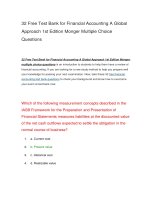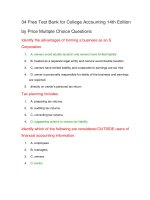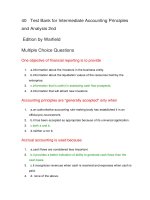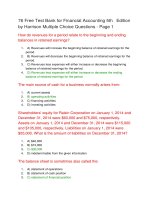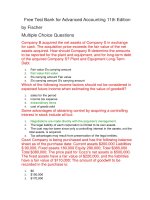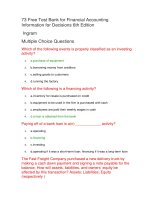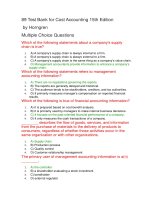40 free test bank for cost accounting foundations and evolutions 9th
Bạn đang xem bản rút gọn của tài liệu. Xem và tải ngay bản đầy đủ của tài liệu tại đây (48.59 KB, 10 trang )
40 Free Test Bank for Cost Accounting Foundations and
Evolutions 9th
Edition by Kinney Multiple Choice Questions
In a global economy,
1.
the trade of goods and services is focused on trade between or among
countries on the same continent.
2.
the international movement of labor is prohibited except for multilingual
persons.
3.
the international flows of capital and information are common.
4.
all of the above happen in a global economy.
Cost and management accounting
1.
require an entirely separate group of accounts than financial accounting uses.
2.
focus solely on determining how much it costs to manufacture a product or
provide a service.
3.
provide product/service cost information as well as information for internal
decision making.
4.
are required for business recordkeeping as are financial and tax accounting.
Which of the following statements is false?
1.
A primary purpose of cost accounting is to determine valuations needed for
external financial statements.
2.
A primary purpose of management accounting is to provide information to
managers for use in planning, controlling, and decision making.
3.
The act of converting production inputs into finished products or services
necessitates cost accounting.
4.
Two primary hallmarks of cost and management accounting are
standardization of procedures and use of generally accepted accounting
principles.
Cost accounting standards
1.
are legal standards set by the Institute of Management Accountants for use in
all manufacturing and professional businesses.
2.
are set by the Cost Accounting Standards Board and are legally binding on all
manufacturers, but not service organizations.
3.
do not exist except for those legal pronouncements for companies bidding or
pricing cost-related contracts with the government.
4.
are developed by the Cost Accounting Standards Board, issued by the
Institute of Management Accountants, and are legally binding on CMAs.
A long-term plan that fulfills the goals and objectives of an
organization is known as a(n)
1.
management style.
2.
strategy.
3.
mission statement.
4.
operational mission.
The world has essentially become smaller because of
1.
improved technology.
2.
trade agreements.
3.
better communications systems.
4.
all of the above.
The balanced scorecard perspective that focuses on using a firm’s
intellectual capital to adapt to the needs of the market through
product or service innovations is the:
1.
learning and growth perspective
2.
internal business perspective
3.
customer value perspective
4.
financial perspective
Which ethical standard is violated when an accountant uses
information from a financial statement he is preparing to advise a
relative of a stock purchase?
1.
Competence
2.
Confidentiality
3.
Integrity
4.
Credibility
The balanced scorecard perspective that addresses concerns about
organizational growth is the:
1.
learning and growth perspective
2.
internal business perspective
3.
customer value perspective
4.
financial perspective
The Institute of Management Accountants' Code of Ethics
1.
is a legally enforceable contract with all management accountants.
2.
should be viewed as a goal for professional behavior.
3.
is a legally enforceable contract with all CPAs.
4.
provides ways to measure departures from ethical behavior.
Management and financial accounting are used for which of the
following purposes?
1.
internal (Management accounting); external (Financial accounting)
2.
external (Management accounting); internal (Financial accounting)
3.
internal (Management accounting); internal (Financial accounting)
4.
external (Management accounting); external (Financial accounting)
Which ethical standard has been violated if an accountant fails to
prepare financial statements according to industry standards?
1.
Competence
2.
Confidentiality
3.
Integrity
4.
Credibility
The value chain
1.
reflects the production of goods within an organizational context.
2.
is concerned with upstream suppliers, but not downstream customers.
3.
4.
results when all non-value-added activities are eliminated from a production
process.
is the foundation of strategic resource management.
The balanced scorecard perspective that addresses how well the
organization is meeting specific customer-based criteria is the:
1.
learning and growth perspective
2.
internal business perspective
3.
customer value perspective
4.
financial perspective
Which ethical standard is violated by an accountant who accepts a
gift from a client
1.
Credibility
2.
Confidentiality
3.
Competence
4.
Integrity
The organization whose primary function is to provide a means to
share information among cost and management accountants in the
United States is the
1.
Internal Revenue Service.
2.
American Institute of CPAs.
3.
Institute of Management Accountants.
4.
Institute of Certified Management Accountants.
Management accounting
1.
is more concerned with the future than is financial accounting.
2.
is less concerned with segments of a company than is financial accounting.
3.
is more constrained by rules and regulations than is financial accounting.
4.
all of the above are true.
Which of the following topics is of more concern to management
accounting than to cost accounting?
1.
generally accepted accounting principles
2.
inventory valuation
3.
cost of goods sold valuation
4.
impact of economic conditions on company operations
Broadly speaking, cost accounting can be defined as a(n)
1.
external reporting system that is based on activity-based costs.
2.
system used for providing the government and creditors with information
about a company's internal operations.
3.
internal reporting system that provides product costing and other information
used by managers in performing their functions.
4.
internal reporting system needed by manufacturers to be in compliance with
Cost Accounting Standards Board pronouncements.
The set of processes that convert inputs into services and products
that consumers use is called
1.
a core competency.
2.
an operational plan.
3.
the value chain.
4.
the product life cycle.
The balanced scorecard perspective that addresses things that an
organization needs to do well to meet customer needs and
expectations:
1.
learning and growth perspective
2.
internal business perspective
3.
customer value perspective
4.
financial perspective
The ethical standards established for management accountants are
in the areas of
1.
competence, licensing, reporting, and education.
2.
budgeting, cost allocation, product costing, and insider trading.
3.
competence, confidentiality, integrity, and credibility.
4.
disclosure, communication, decision making, and planning.
A managerial accountant who prepares clear reports and
recommendations after analyzing relevant facts is exercising which
of the following standards?
1.
objectivity
2.
integrity
3.
competence
4.
confidentiality
A managerial accountant who communicates information objectively
is exercising which of the following standards?
1.
objectivity
2.
integrity
3.
competence
4.
confidentiality
Which of the following statements about management or financial
accounting is false?
1.
Financial accounting must follow GAAP.
2.
Management accounting is not subject to regulatory reporting standards.
3.
4.
Both management and financial accounting are subject to mandatory
recordkeeping requirements.
Management accounting should be flexible.
Core competencies are not
1.
internal functions crucial to the success and survival of a company.
2.
attributes that keep a firm from competing.
3.
different for every organization.
4.
considered influences on corporate strategies.
Which of the following statements is true?
1.
Management accounting is a subset of cost accounting.
2.
Cost accounting is a subset of both management and financial accounting.
3.
Management accounting is a subset of both cost and financial accounting.
4.
Financial accounting is a subset of cost accounting.
Which of the following U.S. legislation relates to bribes being
offered to foreign officials?
1.
Racketeer Influenced and Corrupt Organizations Act
2.
Foreign Illegal Activities Act
3.
Foreign Corrupt Practices Act
4.
Federal Bribery and Corrupt Practices Act
Modern management accounting can be characterized by its
1.
flexibility.
2.
standardization.
3.
complexity.
4.
precision.
Which of the following areas is not addressed by an organization’s
mission statement?
1.
the purpose for which the organization exists
2.
what the organization wants to accomplish
3.
the organization’s strategic plan for fulfilling its mission
4.
how its products can uniquely meet the needs of its customers.
In comparing financial and management accounting, which of the
following more accurately describes management accounting
information?
1.
historical, precise, useful
2.
required, estimated, internal
3.
budgeted, informative, adaptable
4.
comparable, verifiable, monetary
The Foreign Corrupt Practices Act is directed at
1.
U.S. corporations operating overseas.
2.
foreign businesses operating in the U.S.
3.
all businesses dealing with U.S. consumers.
4.
all U. S. businesses with operations in foreign countries.
Which ethical standard has been violated if an accountant fails to
disclose relevant information pertaining to a financial statement?
1.
Competence
2.
Confidentiality
3.
Integrity
4.
Credibility
One major difference between financial and management
accounting is that
1.
financial accounting reports are prepared primarily for users external to the
company.
2.
management accounting is not under the jurisdiction of the Securities and
Exchange Commission.
3.
government regulations do not apply to management accounting.
4.
all of the above are true.
Financial accounting and cost accounting are both highly concerned
with
1.
preparing budgets.
2.
determining product cost.
3.
providing managers with information necessary for control purposes.
4.
determining performance standards.
Cost accounting is directed toward the needs of
1.
regulatory agencies.
2.
external users.
3.
internal users.
4.
stockholders.
Which of the following is not a valid method for determining product
cost?
1.
arbitrary assignment
2.
direct measurement
3.
systematic allocation
4.
cost-benefit measurement
Cost accounting is necessitated by
1.
the high degree of conversion found in certain businesses.
2.
external reporting requirements for manufacturing companies.
3.
management's need to be aware of all production activities.
4.
management's need for information to be used for planning and controlling
activities.
Financial accounting
1.
2.
is primarily concerned with internal reporting.
is more concerned with verifiable, historical information than is cost
accounting.
3.
focuses on the parts of the organization rather than the whole.
4.
is specifically directed at management decision-making needs.
The Institute of Management Accountants issues
1.
Statements on Accounting Research for Managers.
2.
Statements on Management Accounting.
3.
Statements on Managerial and Cost Accounting.
4.
Cost Accounting Standards.
